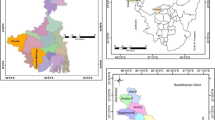Abstract
This paper attempts to explore the correspondence (or lack of it) between women’s access to resources and their social status on one hand and between women’s social status and their values and agency on the other. This would necessarily involve an assessment of the role of women’s access to resources towards their attitudinal transformation and ability to exercise agency. However, this also entails an understanding of the circumstances including norms and institutions amidst which women exercise choices. While gender research today boasts of rich empirical contributions, the implication of women’s improved resource access on intra-family-gendered relation as well as on women’s own preferences and agency roles still deserves a comprehensive inquiry. This paper attempts to conduct such an exercise in Indian context, by utilizing existing demographic health survey and other data. It observes that despite women’s control over resources and access to education, gendered role as well as attitudes and preferences of men and of women themselves, remain intact. While this observation underlines the impinging role of social context, alongside it also reflects the inefficacy of using conventional indicators to measure women’s autonomy and gender equality.
Similar content being viewed by others
Notes
Large city is defined as those with a population of 1,00,000 or above, as per Census of India 2011.
Bodily Integrity: Being able to move freely from place to place; to be secure against violent assault including sexual assault and domestic violence; having opportunities for sexual satisfaction and for choice in matters of reproduction in Nussbaum [23].
Participation in decision-making is based on four NFHS indicators, viz. final say on making large household purchases, on daily household purchases and on visits to family or relatives.
Freedom of movement is based on three NFHS indicators, viz. allowed to go to market, to health facility and to outside community.
References
Agarwal, B. (1997). Bargaining and gender relations: Within and beyond the household. Feminist Economics, 3, 11–51.
Agarwal, B., & Panda, P. (2010). Toward freedom from domestic violence: The neglected obvious. Journal of Human Development, 8(3), 359–388.
Alkire, S. (2008). Concept and measures of agency. Working Paper No. 9, Oxford: Oxford Poverty and Human Development Initiative.
Allendorf, K. (2012). Women’s agency and the quality of family relationships in India. Population Research and Policy Review, 31, 187–206.
Barker, G., et al. (2011). Evolving men: Initial results from the International Men and Gender Equality Survey (IMAGES). Washington, DC: International Centre for Research on Women and Rio de Janeiro, Instituto Promundo.
Chaudhri, D. P., & Jha, R. (2011). India’s gender bias in child population, female education and growing prosperity: 1951–2011 with projections to 2026. ASARC Working Paper No. 2011/14. Canberra: Australian National University.
Cornwall, A. (2007). Myths to live by? Female solidarity and female autonomy reconsideration. Development and Change, 38, 149–168.
Doss, C. (2012). Intra household bargaining and resource allocation in developing countries. Background Paper: Gender Equality and Development, World Development Report.
Dreze, J., & Sen, A. (1995). India, economic development and social opportunity. Oxford: Oxford University Press.
Esping-Andersen, G. (2009). The incomplete revolution: Adapting to women’s new roles. Cambridge: Polity.
Folbre, N. (1994). Who pays for the kids: Gender and the structures of constraint. New York: Routledge.
IMAGES. (2010). International Men and Gender Equality Survey. Washington DC: International Centre for Research on Women.
Jejeebhoy, S. J. (2002). Convergence and divergence in spouse’s perspective on women’s autonomy in rural India. Studies in Family Planning, 33, 299–308.
Kabeer, N. (1999). The conditions and consequences of choice: Reflections on the measurement of empowerment. Discussion Paper No. 8, Geneva: United Nations Research Institute for Social Development.
Kabeer, N. (2005). Gender equality and women’s empowerment: A critical analysis of third millennium development goal. Gender and Development, 13, 113–124.
Kabeer, N. (2011). Between affiliation and autonomy: Navigating pathways of women’s empowerment and gender justice in rural Bangladesh. Development and Change, 42, 499–528.
Kazi, S. (2011). Gender, governance and women’s rights in South Asia. Occasional Paper 57, New Delhi: Centre for Women’s Development Studies.
Klasen, S. (2004). Gender related indicators of well-being. Discussion Paper No. 2004/04. Helsinki: World Institute of Development Economics Research.
Ministry of Health and Family Welfare. (2006). National Family Health Survey 3. New Delhi: Government of India.
Narayan, D. (Ed.). (2005). Measuring empowerment: Cross-disciplinary perspectives. Washington, DC: World Bank.
Nazneen, S., Hossain, N., & Sultan, M. (2011). National discourses on women’s empowerment in Bangladesh: Continuities and change. IDS Working Paper 368. Brighton: IDS.
NFHS-3. (2005–2006). National Family Health Survey-Third Round. Government of India.
Nussbaum, M. C. (2003). Capabilities as fundamental entitlements: Sen and social justice. Feminist Economics, 9, 33–59.
Panda, P., & Agarwal, B. (2005). Marital violence, human development and women’s property status in India. World Development, 33, 823–850.
Razavi, S. (1997). Fitting gender into development institutions. World Development, 27, 1111–1125.
Razzaque, M. A., & Toufique, M. M. K. (2007). Does women’s status matter for food security? Evidence from Bangladesh. Working Paper No. 79. Helsinki: World Institute for Development Economic Research.
Rowlands, J. (1996). Empowerment examined. In D. Eade (Ed.), Development and social diversity (pp. 86–91). UK: Oxfam.
Samman, E., & Santos, M. E. (2009). Agency and empowerment: A review of concept, indicators and empirical evidence. Background Paper for 2009 Human Development Report in Latin America and Caribbean on Agency. Oxford: Oxford Poverty and Human Development Initiative.
Scott, L. (2012). Contested relationships: Women’s economic and social empowerment, insights from the transfer of material assets in Bangladesh. Working Paper No. 2012/02. Helsinki: World Institute for Development Economic Research.
Sen, A. K. (1985). Well-being, agency and freedom: The Dewey lectures 1984. The Journal of Philosophy, 82, 4169–4221.
World Values Survey. (2005–2006). Retrieved from http://www.wvsevsdb.com/wvs/WVSData.jsp.




